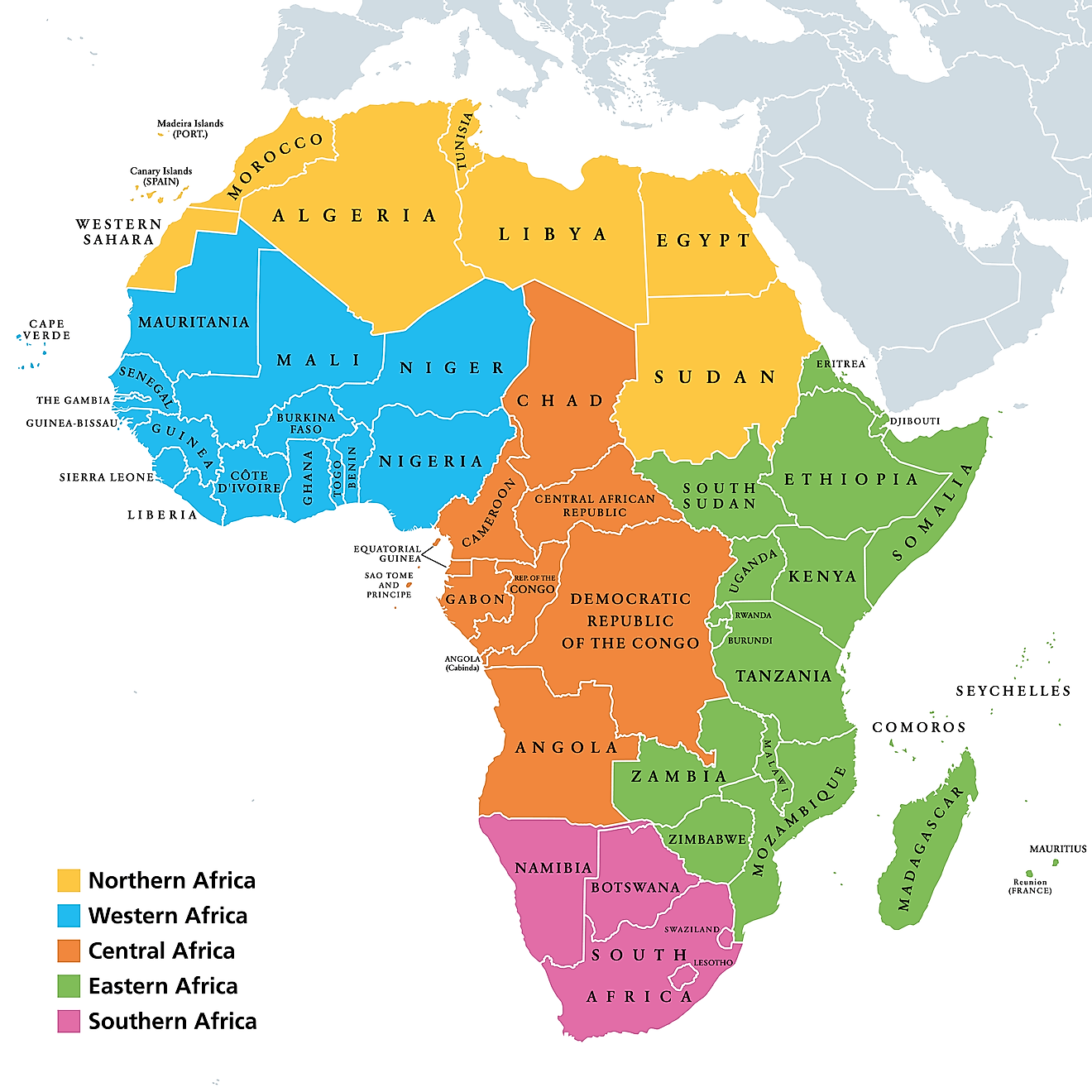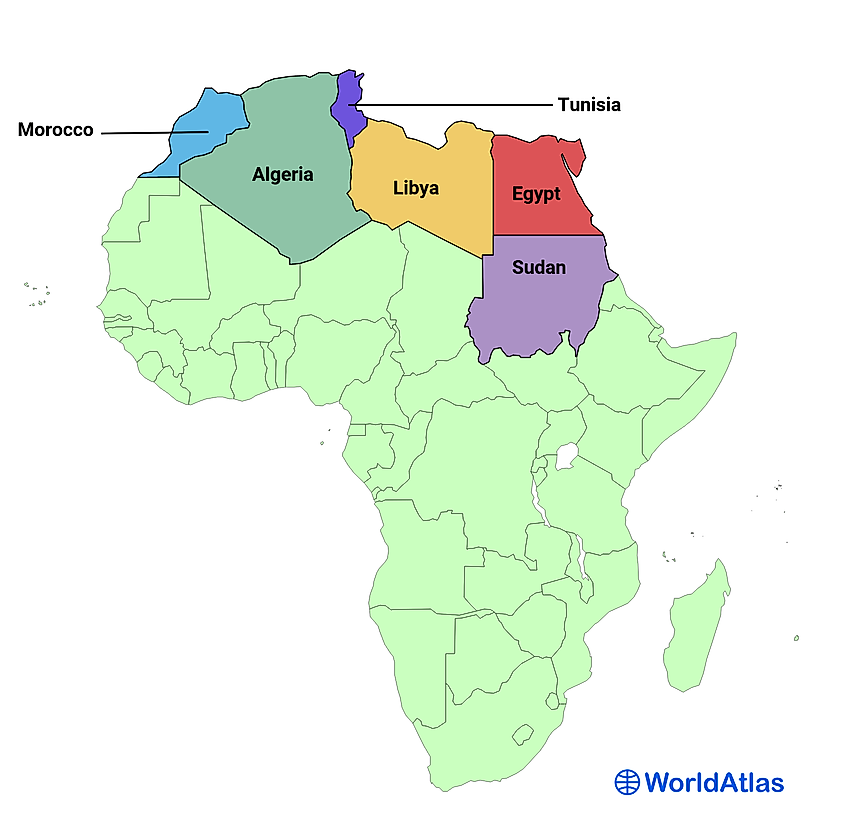Regions Of Africa

- The United Nations Geoscheme divides Africa into 5 subregions: Northern Africa, West Africa, East Africa, Middle Africa, and Southern Africa
- There are 54 countries in Africa.
- An estimated 1.369 billion people live in Africa.
- Nigeria is the most populous country in Africa, while the Seychelles is the least populous.
The continent of Africa contains approximately 1.369 billion people, spread out over 54 countries. The United Nations’ Geoscheme divides the continent into 5 distinct subregions, Northern Africa, West Africa, Middle Africa, East Africa, and Southern Africa. Northern Africa is the largest of the subregions by land area, while Southern Africa is the smallest. Southern Africa is also the least populous of the African subregions. Each subregion is comprised of a number of countries. Northern Africa has just 5 countries, and Southern Africa 6. In contrast, East Africa, the most populous subregion of Africa, contains 18 countries. West Africa has 16 countries, and Middle Africa has 9.
Contents:
Northern Africa

Most of Northern Africa consists of the Sahara Desert, which is why the overwhelming majority of the subregion’s roughly 250 million people live close to the Mediterranean or Atlantic coast. The subregion is comprised of 5 countries: Egypt, Libya, Tunisia, Algeria, and Morocco. Egypt is by far the most populous, with more than 104 million people living within its borders. Libya is the least populous country in the subregion, and has a population of approximately 6.95 million. Northern Africa’s population consists of mostly Arabs, Berbers, and people of mixed Arab and Berber heritage.

The Berbers are indigenous to the subregion, as the Arabs did not come to populate the area en masse until the Muslim conquests of the 7th century. As a result of those conquests, Arabic is the most prevalent language in Northern Africa, and Islam is the most prevalent religion. Like the Arabs, the Berbers are spread throughout Northern Africa, but there are some parts of the subregion in which they are concentrated. For example, the Rif region in Morocco contains a sizeable Berber population that is often at odds with the Arab-led central government. There are also large concentrations of Berbers on the coasts of Morocco and Algeria. A group of Berber known as the Tuareg cover a large expanse of territory in both Northern Africa and Western Africa. Their population in Northern Africa is concentrated in southern Algeria and southern Libya. Other non-Arab populations in the subregion include the Nubians, who live in southern Egypt and northern Sudan; the Fur, who live in the Sudanese region of Darfur, and the Beja, who live mostly on Sudan’s Red Sea coast.
Although Islam is the dominant religion in Northern Africa, there are still other religious communities in the subregion. One of the largest Christian communities in Northern Africa is the Coptic population in Egypt. There also used to be large Jewish communities in nearly all of the countries of Northern Africa. Most of the members of these communities, however, fled or were forced to leave the subregion due to persecution at the hands of the Arab majority. Today, there are just over 3,000 Jews left in Northern Africa.
West Africa

West Africa is comprised of 16 countries. The northern portion of the subregion consists of the Sahel region, which is the semi-arid land that separates the Sahara Desert in the north from the savannas to the south. Half of the countries of West Africa are situated in the Sahel, while the other half are located in the savanna region, close to the Atlantic Ocean. The total population of West Africa is an estimated 411 million, about half of which live in one country, Nigeria, which is the most populous country on the African continent and the 7th most populous country in the world. The country also contains Africa’s largest city, Lagos, which is home to approximately 9 million people. In contrast, West Africa’s least populous country is Cabo Verde, an island country that has a population of about 556,000.

There are a multitude of different ethnic groups and languages in West Africa. Two of the biggest ethnic groups are the Hausa and Fulani, who number about 20 million each. They live mostly in northwestern Nigeria and southern Niger. The Fulani have the distinction of being the largest nomadic group in the world. Other large ethnic groups in West Africa include the Mossi, who make up about half the population of Burkina Faso; the Yoruba and Igbo, who live mostly in southwestern and southeastern Nigeria respectively, and the Arabs, who live in Mauritania. Although the number of people who speak indigenous languages far outnumber those who speak European languages, it is the latter that are the official languages in most West African states. English is spoken in former British colonies such as Ghana and Nigeria, while French is spoken in former French colonies like Niger, Mali, Togo, Benin, and Senegal. Portuguese is spoken in Cabo Verde.
In terms of religion, most of the people in West Africa practice Islam. Christianity, however, is dominant in the savanna regions. In Nigeria, for instance, most of the population in the north are Muslim, while most in the south are Christian. This is a dynamic that is consistent throughout much of West Africa.
Middle Africa/Central Africa

As its name implies, Middle/Central Africa comprises the central part of the African continent. The subregion consists of 9 countries, of which the Democratic Republic of the Congo is the largest and most populous, while Sao Tome and Principe is the smallest and least populous. Middle Africa is home to an estimated 184 million people. DR Congo has a population of more than 89 million. In contrast, Sao Tome and Principe has just 219,000 people living in it.

Like most of Africa, Middle Africa has many different ethnic and linguistic groups. One of the largest are the Kongo, who live in the southern parts of both Congo countries, as well as northern Angola. As you probably guessed, the Congo River and the two countries with Congo in their names, are named after this ethnic group. Other large ethnic groups in Middle Africa include the Luba, who live in the central part of DR Congo, the Hutu, who live in eastern DR Congo, the Ovimbundu and Mbundu of Angola, the Zande in the Central African Republic, the Sara of southern Chad, the Arabs of northern Chad, and the Fang, who live in northern Gabon, southern Cameroon, and Equatorial Guinea.
In addition to their own indigenous languages, the people of Middle Africa also speak European languages as their countries’ official languages. French is the official language in Chad, DR Congo, Congo, Gabon, and the Central African Republic. It is also an official language in Cameroon, alongside English. Portuguese is the official language in both Angola and Sao Tome and Principle, while Spanish is the official language of Equatorial Guinea.
East Africa

East Africa is the most populous of all the African subregions, with a total estimated population of 455 million. A total of 18 countries are considered to be part of East Africa. Almost a quarter of East Africa’s population lives in one country, Ethiopia, which has an estimated population of 117.5 million. In contrast, the Seychelles, an island country situated in the Indian Ocean, has the subregion’s smallest population. Less than 99,000 people live in the Seychelles, which is also the smallest country in all of Africa.

Ethnically and linguistically, East Africa is just as diverse as other parts of the continent. Five East African countries, Djibouti, Somalia, Eritrea, Rwanda, and Burundi have populations in which one ethnic group forms the majority. The people of Djibouti and Somalia are mostly Somali, while the people of both Rwanda and Burundi are mostly Hutu. The Tigrinya make up a little over half of Eritrea’s population.
Christianity and Islam are the two main religions practiced in East Africa, though some also practice indigenous African religions. Islam dominates in Djibouti, Somalia, and the Ogaden region of eastern Ethiopia, while Christianity is prevalent in the rest of the subregion.
Southern Africa

Southern Africa is the smallest and least populous subregion of Africa. Its population is just 68 million, the overwhelming majority of whom live in one country, South Africa. South Africa itself has 60 million people living within its borders, which dwarfs the population of Southern Africa’s 5 other countries. eSwatini, formerly Swaziland, is the subregion’s smallest and least populous country. Indeed, the lone absolute monarchy in Africa has a population of just 1.17 million. Lesotho, with a population of 2.15 million, also has a monarchy, albeit a constitutional one in which the king wields no real political power.

Both eSwatini and Lesotho are among the few countries in Africa in which one ethnic group makes up the overwhelming majority of the population. Hence, eSwatini is inhabited mostly by Swazi, and Lesotho is inhabited mostly by the Basotho. A similar situation exists in Botswana, in which the overwhelming majority of the people belong to the Tswana ethnic group. Namibia does not have a majority ethnic group, though the Ovambo ethnic group makes up about half of its population.
South Africa is the most multicultural of all the countries in Southern Africa. For many decades, however, the black African population largely put their ethnic differences aside in order to fight the racist system known as Apartheid, under which the country’s white population had all the political power, while the non-white population were not even given so much as the right to vote. This all changed in the 1990s, as Apartheid came to an end and South Africa became a multiracial democracy.











